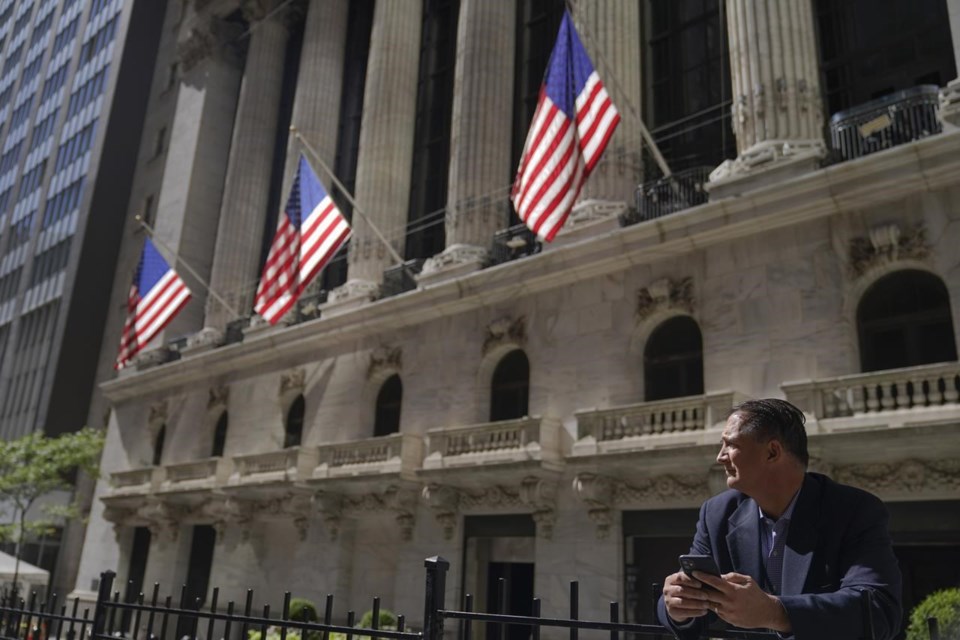NEW YORK (AP) — U.S. stocks edged higher as Wall Street makes few big moves in advance of the Federal Reserve’s next meeting on interest rates. The S&P 500 closed virtually unchanged Monday. The Dow inched up 6 points, and the Nasdaq composite was also little changed. Stocks have been see-sawing since early August on uncertainty about whether the Fed is finally done with its drastic hikes to interest rates. Traders almost universally expect it to keep rates steady this week. More important will be forecasts the Fed gives on where rates may be heading. Treasury yields held relatively steady.
THIS IS A BREAKING NEWS UPDATE. AP’s earlier story follows below.
NEW YORK (AP) — U.S. stocks are ticking higher Monday, and Wall Street is making few big moves overall in advance of the Federal Reserve’s next meeting on interest rates.
The S&P 500 was virtually unchanged in late trading, coming off its second straight losing week. The Dow Jones Industrial Average rose 15 points, or less than 0.1%, at 34,633, as of 3 p.m. Eastern time, and the Nasdaq composite was 0.1% lower.
Stocks have been see-sawing since early August on uncertainty about whether the Fed is finally done with its drastic hikes to interest rates. Higher rates have helped cool inflation from its peak last summer, but they also hurt prices for stocks and other investments while slowing the economy.
Traders almost universally expect the Fed to keep rates steady at its meeting this week, which ends Wednesday. More attention will be on the forecasts Fed officials will publish about where they expect interest rates, the economy and the job market to head in upcoming years.
One of the first the market will fixate on is how high officials at the Fed see its main interest rate rising this year. Traders are betting on a roughly 40% chance the Fed will raise rates again in either November or December, according to data from CME Group.
But just as much attention will be on what Fed officials say about next year, when investors expect the Fed to begin cutting interest rates. Investors crave such cuts, which typically loosen up financial conditions and give boosts to financial markets. The big question is by how much the Fed could cut.
Economists at Goldman Sachs expect Fed officials to indicate a full percentage point of cuts next year, after raising rates one more time this year to a range of 5.50% to 5.75%.
Fears are strong that rates may have to stay higher for longer in order to get inflation fully down to the Fed’s 2% target. While underlying trends on inflation continue to improve mostly, a recent upswell in oil prices has complicated things.
A barrel of U.S. crude rose 71 cents to $91.48 Monday. That’s up from less than $70 in July. Brent crude, the international standard, rose 0.5% to $94.43 per barrel.
Higher prices for gasoline and other fuel were a big reason that inflation consumers are feeling accelerated last month to 3.7% from 3.2%.
The rise in fuel prices, along with worries about rates staying higher for longer, have helped push up Treasury yields across the bond market.
The 10-year Treasury yield edged down to 4.31% from 4.33% late Friday. It’s been mostly climbing since sitting around 3.40% in May.
The two-year Treasury yield, which more closely follows expectations for the Fed, dipped to 5.03% from 5.04% late Friday.
Worries about a possible recession also continue to hang around, even though they’ve diminished with successive reports showing the economy and job market continue to hum.
One worrying factor is where bond yields are, with two-year and other shorter-term yields continuing to remain higher than longer-term yields. That’s an unusual occurrence that has often preceded recessions in the past.
Another warning signal comes from the leading economic indicators index, which looks at new orders for manufacturers, consumer expectations for business conditions and other factors that could show where the economy is heading.
When its six-month annualized rate-of-change contracts 3% or more, it’s always been associated with a recession, according to Doug Ramsey, chief investment officer of The Leuthold Group.
It’s been 15 months since the most recent such warning of a recession triggered in June 2022. In the past, the longest stretch between such a trigger and a recession was the 16 months before the Great Recession. If this matches that one, it could imply a recession beginning in October, Ramsey says.
On Wall Street, Clorox dropped 1.4% after it said a cybersecurity attack caused widespread disruptions to its business. It’s still measuring the damage, but it said it expects it to be material on upcoming results. Clorox also said it believes the unauthorized activity has been contained.
Ford and General Motors were falling as a limited strike by the United Auto Workers carried into another day. Ford fell 2.3%, and General Motors slipped 1.5%.
Stocks of energy producers, meanwhile, were among the stronger gainers because of the rise in oil. Marathon Petroleum rose 1.5%.
In stock markets abroad, the Hang Seng index in Hong Kong fell 1.4% following reports over the weekend that police had detained staff at the wealth management business of troubled real estate developer China Evergrande.
Indexes fell across much of the rest of Asia, as well as in Europe.
___
AP Business Writers Matt Ott and Elaine Kurtenbach contributed.
Stan Choe, The Associated Press



